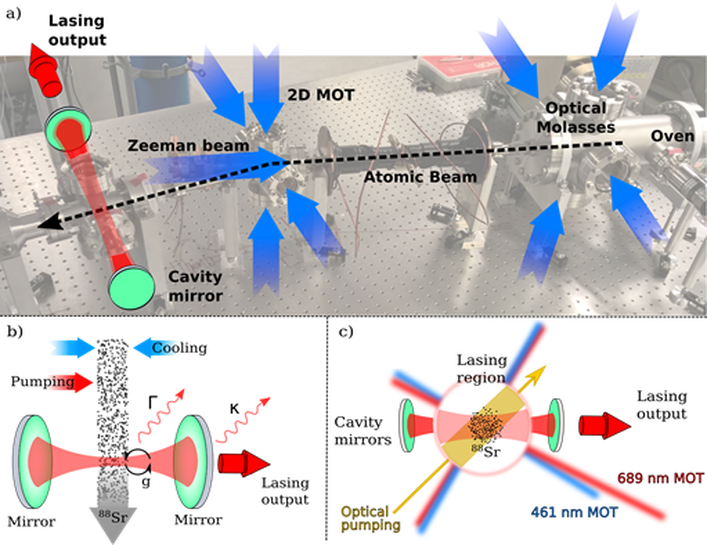Positions in Copenhagen
The Copenhagen team has no open ESR positions
ESR10 - Automated superradiant clock on a kHz wide transition- this position is fulfilled
The early-stage researcher will work on the optimization of lasing dynamics in a superradiant optical atomic clock and the subsequent automation of both a mHz transition and kHz transition superradiant lasers. University of Copenhagen (UCPH) has investigated time-dependent dynamics in mK temperature atomic samples, and furhter investigations of the lasing mechanism in unconfined atoms from a continuous source will be pursued here. The ESR will be part of the direct collaboration between UCPH, and University Nicolaus Copernicus with a secondment at the latter institute. Focus is on experimental infrastructure allowing a robust clock operation and implementation of automated optimization protocols. Visits to University of Amsterdam, DFM (danish fundamental metrology) and NKT photonics will allow excellent training in cold atomic sources, frequency metrology, commercial laser systems and entrepreneurship.
For more information please contact Jan Thomsen.
ESR9 - Ultra stable clock laser system for studies of superradiant clock on a kHz wide transition- this position is fulfilled
The early-stage researcher will develop an ultra-stable reference laser and use it to investigate superradiant lasing on the kHz transition in strontium. University of Copenhagen has realised pulsed lasing on the kHz transition in strontium and will use the know-how from this proof-of-concept in order to realise a continuous superradiant laser on the kHz transition within the iqClock project. Highly stable reference lasers are an essential tool in characterizing atomic clocks, and providing high levels of control in cold atom systems for quantum simulations. By characterizing the frequency characteristics of the superradiant laser the ESR will facilitate the accuracy estimations and developments towards compact superradiant clocks. A secondment at DFM (danish fundamental metrology) will focus on laser stabilisation for optical frequency standards. Visits to University of Amsterdam, University Nicolaus Copernicus and ESP Central will contribute essential training in other superradiant laser systems and their application.
Go to our group homepage.
ESR10 - Automated superradiant clock on a kHz wide transition- this position is fulfilled
The early-stage researcher will work on the optimization of lasing dynamics in a superradiant optical atomic clock and the subsequent automation of both a mHz transition and kHz transition superradiant lasers. University of Copenhagen (UCPH) has investigated time-dependent dynamics in mK temperature atomic samples, and furhter investigations of the lasing mechanism in unconfined atoms from a continuous source will be pursued here. The ESR will be part of the direct collaboration between UCPH, and University Nicolaus Copernicus with a secondment at the latter institute. Focus is on experimental infrastructure allowing a robust clock operation and implementation of automated optimization protocols. Visits to University of Amsterdam, DFM (danish fundamental metrology) and NKT photonics will allow excellent training in cold atomic sources, frequency metrology, commercial laser systems and entrepreneurship.
For more information please contact Jan Thomsen.
ESR9 - Ultra stable clock laser system for studies of superradiant clock on a kHz wide transition- this position is fulfilled
The early-stage researcher will develop an ultra-stable reference laser and use it to investigate superradiant lasing on the kHz transition in strontium. University of Copenhagen has realised pulsed lasing on the kHz transition in strontium and will use the know-how from this proof-of-concept in order to realise a continuous superradiant laser on the kHz transition within the iqClock project. Highly stable reference lasers are an essential tool in characterizing atomic clocks, and providing high levels of control in cold atom systems for quantum simulations. By characterizing the frequency characteristics of the superradiant laser the ESR will facilitate the accuracy estimations and developments towards compact superradiant clocks. A secondment at DFM (danish fundamental metrology) will focus on laser stabilisation for optical frequency standards. Visits to University of Amsterdam, University Nicolaus Copernicus and ESP Central will contribute essential training in other superradiant laser systems and their application.
Go to our group homepage.
|
Figure: Schematic of the UCPH machines configured for use in superradiant laser generation on the 7.4 kHz transition. a) Deflection and cooling stages in the mK beamline apparatus with spatial separation between cooling stages and lasing cavity. b) Overview of the atom-cavity interaction. Here the cold atoms propagate freely and enter the cavity in the excited state. By ensuring that the cavity coupling factor g exceeds decorence in the form of atomic dipole and cavity decays (Γ and κ) a superradiant lasing output may be achieved. c) Cavity setup in the case of the cyclically operated machine. Here only MOT cooling is used to cool the atoms, and quasi-continuous superradiant emission of laser light may be obtained when pumping in between cooling periods.
|


